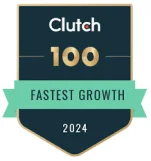Online food delivery has become a global trend in this digitally advanced era. People have started relying on food delivery apps to get food from their favorite restaurants delivered to their doorstep in a span of a few minutes instead of typical and tedious takeaway options.
This is where apps like Deliveroo enter the scene. Deliveroo is one of the few super apps that has successfully made its way into the dynamic landscape of the European food delivery market. This British-based app has established its position as a fortune in the food delivery industry. Catering to the evolving demands and preferences of consumers.
According to experts, in 2021, the value of the online food delivery app market reached $50.70 billion and is expected to rise even more at a CAGR of 18.7% from 2022 to 2030. This data showcases the bright future of food delivery apps like Deliveroo in the thriving market.
Whether you are a restaurant owner or an entrepreneur wanting to create your restaurant app or you want to invest and develop an app like Deliveroo, we have only one piece of advice for you: Now is the best time to do it! However, developing an app as amazing as Deliveroo is indeed challenging and involves lots of steps. But don’t worry; we are here to make things easy for you.
Today in this blog, we’ll learn how to develop a food delivery app like Deliveroo. We’ll also guide you through its crucial aspects like cost, development stages, features, and more. So fasten your seat belts and dive into this informative journey to food delivery app development!
What does the Deliveroo app entail?
As one of the best apps dedicated to food delivery, Deliveroo connects customers with a wide range of local restaurants through its user-friendly website and app. It provides an opportunity for restaurants who don’t have an opportunity to introduce their recipes to consumers.
The platform provides services in various countries and serves as a bridge between customers and restaurants, enabling seamless transactions without the need for in-house kitchens. The best thing about Deliveroo is that it offers a “click and collect” service, which permits customers to choose their food from their favorite restaurants and cafes.
The company employs motorists and cyclists to deliver food and offers a tracking service so that users know where their food is at all times. In simple terms, this app helps users order their favorite food without any inconvenience.
Market overview of food delivery apps like Deliveroo
- In 2023, Deliveroo’s mobile application was downloaded over nine million times globally.
- In 2023, British online food delivery company Deliveroo reported 290 million orders made on its platform worldwide, slightly under the previous year’s total of 299 million.
- Deliveroo’s revenues reached an all-time high of just over two billion British pounds in 2023, up from the previous year’s figure of 1.9 billion.
- During the fourth quarter of 2023, British food delivery company Deliveroo reported approximately four million average monthly active consumers in the UK and Ireland. Meanwhile, this figure stood at 3.3 million in the company’s international markets.
Types of Food Delivery Apps
The craze for food delivery apps has crossed the rails, offering various models to meet the different needs of consumers and business strategies. Here are the different kinds of food delivery applications:
1. Platform-to-Consumer Delivery Apps
These applications connect consumers directly with different types of restaurants within a specific area. From order placement to delivery, the app manages everything. The biggest advantage this business model offers is minimal capital investment. Business owners can begin small with just a few restaurants but gradually expand by adding more restaurants.
Examples include:
- Uber Eats
- DoorDash
- Grubhub
Features:
- Wide selection of restaurants
- Real-time order tracking
- Multiple payment options
Develop a feature-rich food delivery app that delights customers and drives your business forward.
2. Restaurant-to-Consumer Delivery Apps
Restaurant-to-consumer delivery is one of the subsidiary categories of food delivery apps. It includes management of delivery and logistics managed by the restaurants themselves. These apps act as digital bridges between customers and restaurants. It offers a convenient way to order food without depending on third-party delivery services.
Examples include:
- Domino’s Pizza
- KFC
- McDonald’s
Features:
- Direct customer engagement
- Control over food quality and delivery times
- Custom promotions and loyalty programs
3. Food delivery aggregator apps
These apps assemble multiple restaurants from different regions into multiple platforms; however, they do not handle the delivery themselves. Instead, they are the bridge connecting customers with restaurants that manage their deliveries. The best thing about this model is that it is a very feasible business model as the restaurant does not have to manage its fleet. Moreover, it also allows you to leverage the existing customer base of your app.
Examples include:
- Zomato
- Swiggy (in India)
Features:
- Comprehensive restaurant listings
- User reviews and ratings
- Order tracking through the restaurant’s system
4. Grocery and Meal Kit Delivery Apps
These applications are for users who prefer cooking at home instead of ordering cooked meals by ordering groceries or pre-portioned meal kits with recipe instructions. They offer a convenient way to shop for ingredients or prepare meals without the hassle of meal planning or visiting stores. Users can select dietary preferences, specific ingredients, or portion sizes to suit their tastes and needs.
Examples include:
- HelloFresh
- Instacart
Features:
- Recipe suggestions with ingredients
- Scheduled deliveries
- Subscription models for regular deliveries
5. Specialty Food Delivery Apps
These apps are to serve niche markets, such as organ, vegan, or health-focused food options. They often partner with specific restaurants that align with their brand values. These apps often collaborate with restaurants, food providers, and cafes to share their commitment to the niche, ensuring an authentic and curated experience for customers.
Examples include:
- Thistle (healthy meals)
- Veestro (plant-based meals)
Features:
- Focus on specific dietary needs.
- Curated menus
- Educational content about nutrition
6. On-demand Delivery Apps
On-demand delivery apps have revolutionized the way consumers access goods and services by providing fast, convenient, and flexible solutions tailored to their needs. These apps enable users to order and receive items such as food, groceries, medicines, or even personal services with just a few taps on their smartphones.
Examples include:
- Postmates
Features:
- Fast delivery times
- Variety of food options
- Real-time tracking
Read Also:- Top 12 Food Delivery Apps in the UAE: A Guide to Talabat Alternatives
Challenges in developing food delivery apps
You may encounter various challenges while developing a food delivery app like Devileroo. Some of these challenges in building Deliveroo-like apps are given below.
1. Unstable Pricing Model
Due to the competition in the food delivery industry, your food delivery app may often have to deal with fluctuating pricing statistics. To lure users, startups introduce low-margin pricing, which impacts profitability, especially when food costs are volatile. It calls for constant adjustments to pricing strategies to reach a middle ground between profitability and competitiveness.
2. Unpredictable Food Quality
Another significant challenge when it comes to delivering food is quality maintenance. Factors like transportation conditions can affect freshness and presentation, which may displease customers. To solve this issue, businesses must carefully vet restaurant partners and ensure strict hygiene in packaging and quality standards.
3. Managing Logistics
One of the most important yet complex aspects of food delivery services is logistics management. Higher order volume can be overwhelming for delivery personnel, especially during peak times. Effective logistics require sophisticated and well-organized systems to prioritize orders, optimize routes, and make timely deliveries. Technology solutions like delivery scheduling and GPS tracking can help streamline this process.
4. Partnering with Restaurants
To provide quality service to customers, it is important to find the right restaurant partners. This process can be time-consuming, with several selection phases involved to ensure that partners meet the quality standards. Moreover, maintaining good relationships with these partners is crucial for service consistency.
5. Meeting Customer Expectations
In this competitive food delivery industry, customers have high expectations from delivery apps. They expect the apps to provide reliable and speedy delivery service, real-time updates, efficient communication with customers, and a live tracking system. Failing to meet these expectations can cause consumer dissatisfaction and loss of business.
6. Competition from Established Players
New restaurants entering the food delivery market face strong competition from established brands with loyal customer bases. To succeed in this competitive business, you need unique value propositions like superior customer service or exclusive partnerships with popular restaurants.
These are the few challenges new food delivery apps might have to face while entering the food delivery market.
Essential features for developing food delivery apps like Deliveroo
Developing a food delivery app like Deliveroo requires a great set of features and functionalities to ensure a seamless and engaging user experience for customers, partners, restaurants, and delivery personnel. Here are some of these essential features:
Customer Features
- User-Friendly Interface: This feature is important to offer seamless navigation to search for restaurants, customize orders, and keep track of deliveries.
- Real-Time Order Tracking: To build Deliveroo alternatives, features like GPS-enabled tracking are essential to provide customers updates about the order’s progress.
- Multiple Payment Options: If you want to create an app like Deliveroo, then make sure to add numerous payment modes like digital wallets, credit cards, and cash on delivery.
- Search and Filter Tools: Adding filter tools is important in food delivery apps for users to filter cuisine, price range, ratings, and delivery time.
- Personalized Recommendations: Add personalized recommendations, which are basically AI-based suggestions according to user’s preferences and previously placed orders.
- Push Notifications: This feature sends alerts for order updates, discounts, and exclusive deals.
- Ratings and Reviews: Don’t forget to incorporate ratings and review features. It provides feedback and reviews on food, service, and delivery.
Restaurant Partner Features
- Order Management: This feature is necessary to accept, prepare, and track income orders.
- Menu Management: This feature offers easy updates to pricing, items, and availability.
- Sales Analytics: Adding sales analytic features offers insights into sales trends, popular items, and performance metrics.
Delivery Personnel Features
- Driver App Module: This feature provides access to delivery requests, route navigation, and earnings details.
- Route Optimization: This feature includes algorithms to determine the fastest delivery path.
- Earnings Dashboard: Adding this feature is important to track daily earnings and completed deliveries.
Admin Panel Features
- Comprehensive Dashboard: Real-time insights into orders, revenues, and user activity.
- User and Partner Management: Oversee customer profiles, restaurant accounts, and delivery agents.
- Performance Analytics: Reports on app performance, delivery times, and user retention.
Core Technical Features
- Scalable Backend: Ensures smooth operation during peak usage.
- Secure Data Encryption: Protects sensitive user and payment information.
- Third-Party Integrations: seamless connection to payment gateways and GPS services.
- Multilingual Support: Essential for catering to diverse markets.
Key Steps to Develop a Food Delivery App Like Deliveroo
Making a successful app like Deliveroo, one of the best Uber Eats alternatives, is not a child’s play. Deliveroo-like food delivery app development involves various steps. In order to handle highly automated tasks, you need to add the best features, programming languages, and tech stacks for a smooth run. So, take a look at these app development processes:
1. Conceptualization and Market Research
The first stage of development involves identifying the requirements, objectives, and goals of your project. Research the already existing and successfully running food delivery apps to help businesses understand their weaknesses and strengths and follow the market trends of relevant industries. Additionally, pay attention to primary and secondary users of the app.
2. IncludeCore Features
In this stage of app development, you need to hire qualified and experienced development teams to incorporate all essential and advanced features in your food delivery app. Create a list of essential features that you want in your app and prepare a list of implemented features. If you are a small start-up, then avoid adding advanced features to reduce the development cost.
3. Choose the Right Tech Stack
Now in this stage of development, choose the right tech stack to develop food delivery applications. This includes advanced tech stacks like programming languages, cloud storage, deployment platforms, databases, APIs, and backend processes. So, to handle automated tasks, you must select the best tech stacks.
4. Design UI/UX
In the fourth stage of app development, employ mobile app developers to design an intuitive interface that enables users to interact easily with the features of the app. It includes several premium themes, plugins, layouts, and inbuilt designs. Keep the design simple to attract users’ attention so that they can easily connect to your app.
5. Development of App
Once you are done with the designs, let’s move on to the development stage. The first thing you need to do is hire a skilled and experienced mobile app development company or development team to build a unique and successful food delivery application. The app’s development is the most crucial phase in which developers integrate modes or services, essential and advanced features, built-in functions, and modules or classes.
6. Testing and QA
Testing and QA are equally important in the development phase. Once the development process is complete, your app needs to go through rigorous testing under different conditions and fix bugs or glitches. Testing includes ensuring that all functions and features are working smoothly or correctly. It ensures the app’s quality does not decrease and stays at its exact quality.
7. Launching and Marketing
Launch your food delivery app with selected platforms, such as iOS and Android. Hire a highly qualified development team to publish the app successfully with all the features and functionalities. The marketing phase includes affiliate marketing, email marketing, paid collaborations, and sharing on social media platforms.
Deliver exceptional food experiences with a custom-built app designed to elevate your business.
Cost requirement for developing food ordering apps like Deliveroo.
The food delivery app development cost can differ depending on various factors like app features, tech stack, complexity, location of developer, platform (iOS, Android, or both), development time, and experience of the development team. Below are some of the cost-influencing factors:
Application Development
This includes the cost of user interface (UI) and user experience (UX) design, user interface development, backend development, and integration of various features.
| Application Type | Simple App (Basic Features) | Medium Complexity App | Complex App (Advanced Features) |
|---|---|---|---|
| Mobile App (iOS/Android) | $10,000 – $50,000 | $50,000 – $150,000 | $150,000 – $500,000 |
| Web App | $15,000 – $50,000 | $50,000 – $200,000 | $200,000 – $1,000,000+ |
| Desktop App | $20,000 – $60,000 | $60,000 – $250,000 | $250,000 – $1,500,000+ |
Technology Stack
The cost of food delivery apps can also be affected by the choice of tech stack. Native app development tends to be more expensive than cross-platform development with the help of frameworks like Flutter or React Native.
| Technology Stack Component | Cost Level (Low – High) |
|---|---|
| Front-end Development (HTML, CSS, JavaScript) | $5,000 – $30,000 |
| Mobile App Framework (React Native, Flutter) | $10,000 – $50,000 |
| Native iOS Development (Swift) | $15,000 – $80,000 |
| Native Android Development (Java/Kotlin) | $15,000 – $80,000 |
| Backend Development | $10,000 – $50,000 |
| Backend Framework (Node.js, Django, Ruby on Rails) | $10,000 – $40,000 |
| Database Setup and Management | $5,000 – $20,000 |
| API Integration | $5,000 – $30,000 |
Features and Functions
The cost of Deliveroo app development also depends on features. The more feature-rich your app will be, the higher the cost of development will be. Here are some of the most popular features that developers integrate into the app, including login and registration, order placement, real-time order tracking, and more.
| App Feature | Cost Range |
|---|---|
| User Registration/Login | $500 – $2,000 |
| User Profiles | $500 – $2,000 |
| Push Notifications | $500 – $1,500 |
| In-App Messaging | $1,000 – $3,000 |
| Social Media Integration | $500 – $2,000 |
| Geolocation/GPS | $1,000 – $4,000 |
| In-App Purchases | $1,000 – $3,000 |
| Real-time Chat | $1,500 – $5,000 |
Conclusion
The above-provided details and information discuss how to develop a food delivery app like Deliveroo. If you’re a new entrant wanting to enter the food delivery app market, then the above-listed factors, features, and steps can be a huge help. By focusing on customer-centric features, seamless operations for restaurant partners and delivery personnel, and a strong backend infrastructure, you can create a platform that meets market demands and delivers a superior user experience. Contact our experts If you want to create your successful food delivery app and stay tuned for more informative updates.
FAQs
Ans. The complexity and features of the app determine how long it takes to develop. It may take three to six months for a basic app, and eight to twelve months or more for a fully functional platform with sophisticated integrations.
Ans. Features, platform (iOS, Android, or both), developer fees, and software complexity all affect the price. A basic app might cost between $20,000 and $50,000, but a more sophisticated one might cost $100,000, $200,000, or more.
Ans. Revenue models include delivery charges, service fees, commission from restaurant partners, subscription plans for premium users, and advertising opportunities for restaurants or other businesses.
Ans. Yes, you must comply with local business regulations, obtain necessary licenses for food delivery operations, and ensure legal agreements with restaurant partners.












